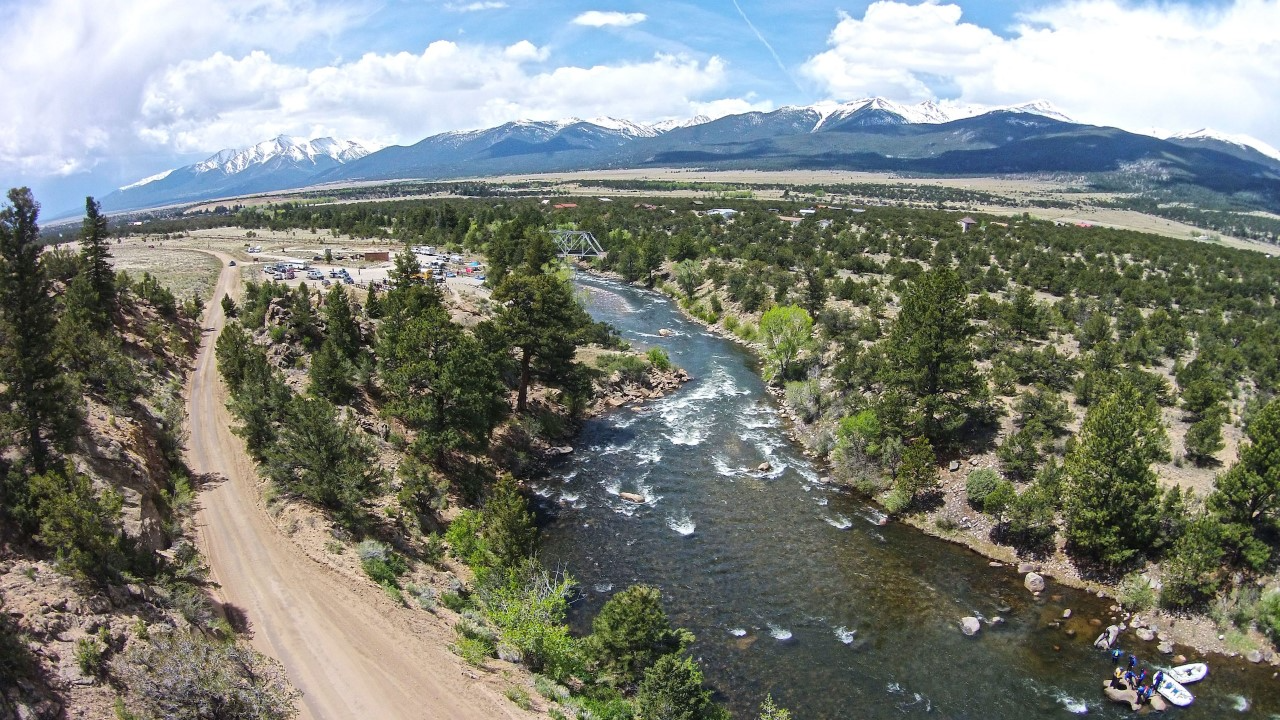Envision Forest Health Council partners will treat the overgrown forest above the Arkansas River north of Buena Vista to improve wildlife habitat and reduce risk of wildfire and its potential effects on area residents and infrastructure.
Railroad Bridge is the third forest treatment project to be prioritized and funded under the Council, which formed last year to implement the Chafee County Community Wildfire Protection Plan.
The project is in the wildfire plan’s top priority areas that identifies where to treat forests for the highest cost efficiency and community benefit. Treatments involve thinning by hand and machine, and then burning slash piles when conditions allow.
The project area is located three miles north of Buena Vista on the east side of the Arkansas River in the piñon-juniper forest above The Numbers and Narrows boating sections. The southern project boundary starts just north of the tunnels near Elephant Rock and the northern boundary is near the Otero pump station.
Forest treatments in the steep, rugged terrain help protect the town and surrounding community from a wildfire in the Buffalo Peaks, where fire suppression could prove difficult in the 40,000-acre Wilderness Area.
The National Forest Foundation, a member of the Forest Health Council, won $454,000 in funding in a competitive Restoration and Stewardship of Outdoor Resources and Environment (RESTORE) Colorado grant process to treat 380 acres in the project area by 2022. The Town of Buena Vista contributed $10,000 in matching funds.
RESTORE Colorado (link: https://www.nfwf.org/programs/rocky-mountain-rangelands/restore-colorado-program) is a partnership among the National Fish and Wildlife Foundation (NFWF) and Great Outdoors Colorado, the Gates Family Foundation, Colorado Department of Natural Resources, Colorado Parks and Wildlife and the Colorado Water Conservation Board.
The public-private partnership combines and leverages state, federal and corporate funding for projects that have the greatest benefit for wildlife habitat and local communities. “We are improving and expanding wildlife habitat throughout the state,” said Jeff Trandahl, executive director and CEO of NFWF. “This program, in partnership with public agencies and private landowners, will help create a better future for both Colorado’s native species and its citizens.”
NFF created the Upper Ark Forest Fund (link: https://envisionchaffeecounty.org/upper-ark-forest-fund-to-support-wildfire-plan-implementation/) this year to accelerate forest treatments in the Upper Arkansas watershed. As the Congressionally chartered partner of the U.S. Forest Service, the organization manages on-the-ground projects on national forest lands by aggregating funding, hiring contractors and helping to oversee the work.
“We’re very grateful for the opportunity to partner with so many esteemed organizations to support large-scale restoration projects leading to meaningful outcomes across the great state of Colorado,” said GOCO Executive Director Chris Castilian. “And thank you to the grantees working so diligently on the ground to accomplish them. We’re pleased that the RESTORE program provides a single-source funding opportunity, streamlining application processes and creating efficiencies in getting critical restoration work completed.”
The Arkansas River sits just below the project area. Forest treatments protect the river from potential post-fire flooding, debris flows and erosion caused when intense fires sterilize the soil and prevent rain absorption and vegetation regrowth for years afterward.
An important wildlife migration area
The Railroad Bridge project encompasses nearly 3,000 acres of prime wildlife habitat, especially for Rocky Mountain bighorn sheep but also mule deer, elk and other animals. It is an important migration corridor tying into Fourmile where animals spend the winter, then disperse north and south to summer ranges as far away as Breckenridge and Westcliffe.
“This project improves some of the most important wildlife habitat in Chaffee County and serves double-duty by reducing wildfire risk,” U.S. Forest Service Leadville District Ranger Patrick Mercer said. “Removing some of the trees encourages grass and forb growth in those areas. That improves wildlife forage, while breaking up some of the continuous heavier fuels in the process.”
Local populations of bighorn have declined 29% in 20 years as their habitat shrinks because of human development, outdoor recreation growth and the loss of forage under thick stands of old trees. The latter reason is chiefly impacting wildlife in the Railroad Bridge area.
Thinning piñon-juniper trees allows new vegetation to grow and, for bighorn sheep, opens the forest so they can use their keen eyesight to detect and avoid predators from up to a mile away, escaping to cliffy terrain.
Railroad Bridge also protects the Otero pump station from wildfire. The station moves water from west of the Continental Divide to Front Range water suppliers serving millions of Colorado residents. The treatment area is located near completed and planned projects designed to protect homes and community infrastructure:
— The Bureau of Land Management treated 185 acres near the Mount Harvard Estates subdivision’s 43 homesites. The long-time project eliminated more than 2,000 piles of wood slash and was completed in early 2021.
— Sangre de Cristo Electric Association plans to clear vegetation from rights-of-way along more than 14 miles of power lines outside of the project area east of the river.
The Forest Health Council received RESTORE Colorado funding in 2020 to support the Methodist Front (link: https://envisionchaffeecounty.org/salida-poncha-wildfire-mitigation-project-planned/) community fuel break near Salida. A second, mid-county fuel break will be created this fall along Coyote Valley Road (link: https://envisionchaffeecounty.org/forest-health-council-plans-a-mid-county-fuel-break/).








